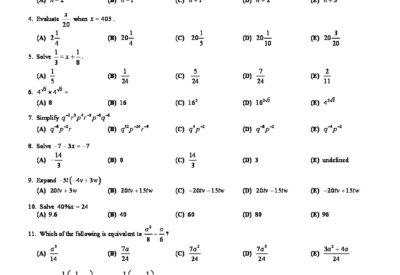Parenting(Age 5 to 8) | Academic | General | Parenting(Age 9 to 12) | Parenting(Age 13 to 16) | Jul 23, 2021
What Do You Need To Know Before Taking A STAAR® Algebra I Test?

The STAAR® Algebra I test covers topics that are typically taught in the first semester of algebra. The STAAR® Algebra I test has two types of items: multiple choice and constructed response.
- Multiple-choice items present students with four possible answers, only one of which is correct.
- Constructed response items require students to produce their valid responses to a question.
Students are given 55 minutes to complete the multiple-choice section, and 50 minutes to complete the constructed response section.
This guide can help you prepare for your STAAR® Algebra I test using the following:
- Learn about a variety of test features.
As indicated in the previous sections, your test will have constructed responses as well as multiple-choice items. It also has separate time limits for each section. All of these things are part of normal testing conditions that you will need to know before you begin a STAAR® test. You should spend a few minutes reviewing them now before you begin your preparation activities so that you can begin practicing with them and having experience with them before you take your test.
- Learn the most common formulas and equation types.
Your test contains a variety of different formulas and equation types. These include fractions, percentages, square roots, as well as cross multiplication and division. You should spend a few minutes reviewing these types of questions so that you can be prepared to approach them with a plan in mind, in case the format of a question has unexpected features such as those listed here and you are not aware of how to approach it.
- Review the key terms for each chapter of Algebra I offered in the STAAR® test specifications booklet. Each chapter includes items that students must know before they attempt to answer each question on that chapter’s test.
- Review the different types of answer choices for each test item and their corresponding techniques.
The first type of construct is a multiple-choice answer, consisting of possible responses to a question. Your test will contain four choices with only one being correct. Before you start working on your test, you should review the options so that you know how to approach a question on which you are unsure what to choose, or if reading all of the choices in the Options column would help you select your best choice before beginning a response.
Another type of question consists of an “arrow” that allows students to choose an answer as they proceed through the questions in a certain order. In this case, students can only select their answers when they reach the correct option. The sections of a STAAR test and the questions that appear in each are indicated on your Test Specifications document.
The third type of question has a unique answer choice that is referenced by a formula or equation. You should review these items so that you know how to approach them and how best to approach them to maximize your chances of selecting the correct answer choice if one appears on your test.
- Understand the test format
Just like on the STAAR®, your test will have 4 chapters and each chapter will have 15 questions that must be completed in 45 minutes. Test takers will need to navigate through a series of problem-solving questions or be given a single task to complete. The test is timed, beginning with a period of 35 minutes allotted for each section followed by an unspecified amount of time for you to complete your responses during the last 10 minutes of testing. This may lead students to rush through the first portion to allow more time for later responses, which could lead them to stress out or make careless mistakes they would not otherwise make because they are not thinking as clearly as they did at the beginning of their exam.
- Know the types of questions that are on your test.
The number and diversity of questions on your exam vary, but you will likely see a mix of multiple-choice, true-false, short answers, and essay questions. You may also see items with numbers you have to identify that can only be identified with some type of answer key. Allow yourself a great deal of time to work through all the options for each item so that you make the correct selection rather than choosing the wrong one because you did not have sufficient time to read each question thoroughly to select the right response.
- Weigh the value of the “right” answer. Since you will have only about 10 minutes to complete each test item, it is important to make sure that you select the correct response for every question. You should spend sufficient time on each question to know that you chose the correct response, and then move on to the next one with confidence in your decision.
- Review all the answers and check them against your notes or even individual questions on your exam to ensure you have not missed a detail. The questions may contain text that deals with material that has been covered elsewhere in class and is no longer covered in lecture and/or lab material. This can be a common occurrence, so you should review all the answers and check them against your notes or even individual questions on your exam to ensure you have not missed a detail.
- Practice with the different types of questions, and select your best responses from those you cover most frequently. The multiple-choice section can be particularly daunting, as it will contain four different answers for students to identify and choose from. You should begin by selecting one of those choices with confidence that it is the correct one; however, this does not mean that you should immediately move onto the next choice without thoroughly reviewing all four options before choosing. If you are unsure, then you should review each one before choosing the one that you feel is the best answer.
- Studying for the multiple-choice section can significantly impact your final score (more than most people realize). Most of the time, a student’s SAT or ACT score will be more closely related to their high school grades than it will to their performance on an entrance exam. If this trend holds here as well, then students must understand how much they can improve their scores by studying for and taking practice tests. You will need to review your first-year STAAR scores before you take your second test if you want to be prepared for each section, and it is better to review your scores in the first place because the questions on each are different.
- Know what type of questions you will be answering on each chapter’s test in advance by taking some practice tests (see the section on practice tests). In order to achieve a high score, students should know what type of questions are on their exam ahead of time. For example, students should be able to identify the types of multiple-choice and true-false questions and those with formulas or equations attached.
This is all that you need to know about the STAAR Algebra test.
















Post a Comment: